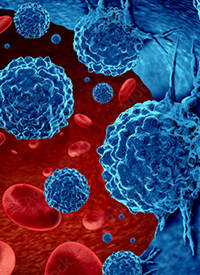News
Article
EZH2 Expression and TP53 Mutation Results in Inferior Outcomes in MCL
Author(s):
TP53 mutation and EZH2 expression negatively affect outcomes in mantle cell lymphoma, with a synergistic negative effect.
Lymphoma

The presence of a TP53 mutation negatively affects outcomes in patients with mantle cell lymphoma (MCL), as does EZH2 expression, and taken together the negative effect is synergistic, according to findings from a study published in Human Pathology.
Findings from an 11-gene next-generation sequencing panel showed that EZH2 overexpression was present in 42% of the 81 patients with MCL in the study, and was correlated with an aggressive histology (P = .005), a high Ki-67 proliferation rate (P < .001), and p53 mutant pattern (P = .001). The panel also identified a total of 149 mutations present in 68 patients in the study (84%) and the median number of mutations present was 2 (range, 0-5) per patient. The most common mutations were ATM (48.1%), TP53 (28.4%), CCND1 (19.8%), KMT2D (14.8%,) and UBR5 (12.3%), which investigators noted had median variant allelic frequencies (VAFs) of 40.5%, 35.6%, 40.4%, 36.3%, and 38%, respectively, indicating that they were major clones.
When examining the total cohort of patients, the presence of a TP53 mutation was associated with aggressive histology (65.2% vs. 25.9%, P = .002) vs wild-type TP53. Additionally, a high Ki-67 proliferation rate (65.2% vs. 33.9%, P = .014) and p53 mutant pattern by immunohistochemical stain (78.6% vs. 6.8%, P < .001) were also seen, respectively.
“[Prescence of a] TP53 mutation and EZH2 expression demonstrated overlapping features including aggressive histology, high Ki-67 proliferation rate, and p53 mutant pattern by immunohistochemistry,” study authors wrote. “EZH2-[positive] MCL commonly harbors [a] TP53 mutation [and] EZH2 expression correlates with [a] high Ki-67 proliferation rate irrespective of TP53 mutation in MCL. Aggressive histology is associated with EZH2 expression or [a] TP53 mutation, possibly via independent mechanisms. [The] p53 mutant pattern by immunohistochemistry, commonly seen in EZH2-[positive] MCL, is due to [the] TP53 mutation.”
Additionally, when examining TP53 mutations, investigators found that patients with EZH2-positive disease were more likely to have the mutation than those with EZH2-negative disease at rates of 41.2% vs 19.1%, respectively (P = .045).
“There were no significant differences in terms of mutation frequency in other genes between the 2 groups. TP53 mutations were present throughout the gene and no recurrent mutation[s] were present in both groups. The median VAFs of the TP53 mutation were similar (32.1% vs 38%, respectively; P = .593),” study authors noted. “Correlation between EZH2 expression and high Ki-67 proliferation rate was observed irrespective of TP53 mutation status,” they added.
Data from the study was compiled from a prior cohort of patients (n = 150) whose EZH2 expression status was collected at The University of Texas MD Anderson Cancer Center and patients who were available for formalin-fixed paraffin-embedded (FFPE) blocks were included. All patients had MCL per the WHO Classification System and treatment-naive, de novo disease. Those with leukemic, non-nodal MCL cases were not included in the study.
Patients underwent genetic testing with the customized 11-gene panel (n = 81) which included ATM, BIRC3, CCND1, KMT2C, KMT2D, NOTCH1, NOTCH2, RB1, TP53, TRAF2,and UBR5 mutations. The median age of patients at diagnosis was 61 years (range, 39-88). Most patients were male (81.0%) and had advanced disease (92.2%), classic histology (63.0%), EZH2-negative (58.0%) disease, Ki-67 low disease (57.0%), and a non-mutant p53 pattern of expression (76.0%). Additionally, patients had a MIPI-b score of low (18%), intermediate (38%), or high (43%) and had received treatment with HyperCVAD with or without rituximab (Rituxan; 77%); rituximab, cyclophosphamide, doxorubicin, vincristine and prednisone (16%); observation (2%); or data was unavailable (5%).
Moreover, EZH2-positive MCL and the presence of a TP53 mutation did not correlate with aggressive histology (P = .495) or high Ki-67 proliferation rate (P = .198) but did correlate with p53 mutant pattern (P < .001). However, EZH2-negative MCL and the presence of a TP53 mutation correlated with aggressive histology (P = .003) and p53 mutant pattern (P = .029).
Investigators found that EZH2 overexpression was associated with an inferior overall survival in MCL. Additionally, “in patients with [a] TP53 mutation, EZH2 overexpression did not show [a] significant difference in overall survival [P = .241]. In patients with wild-type TP53, however, EZH2-[positive] MCL demonstrated significantly worse outcomes [P = .005].”
Reference
Kim DH, Siddiqui S, Jain P, et al. TP53 mutation is frequent in mantle cell lymphoma with EZH2 expression and have dismal outcome when both are present. Hum Pathol. 2024;146:1-7. doi:10.1016/j.humpath.2024.03.002




%20(2)%201-Recovered-Recovered-Recovered-Recovered-Recovered.jpg?fit=crop&auto=format)

%20(2)%201-Recovered-Recovered-Recovered-Recovered-Recovered.jpg?fit=crop&auto=format)
%20(2)%201-Recovered-Recovered-Recovered-Recovered-Recovered.jpg?fit=crop&auto=format)